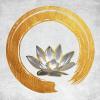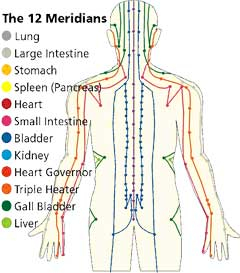 Submitted by LI - Executor on
Submitted by LI - Executor on

Acupressure was developed in Asia over 5,000 years ago. Acupressure uses the same pressure points and meridians as Acupuncture but involves no needles. It is an ancient healing art using the fingers to gradually press key healing points, which stimulate the body's natural self-curative abilities. Using the power and sensitivity of the hand, Acupressure is used to balance body energy, reduce muscular tension, reduce stress levels, increase circulation, and enable deep relaxation. All this strengthens the immune system and resistance to disease and promotes wellness.
How does it work?
Acupressure Points have a high electrical conductivity at the surface of the skin, and thus conduct and channel healing energy most effectively. This is why the most potent healing energy work uses acupressure points. The Chinese call healing energy Qi or Chi. In Japan, the life force is termed Ki, and channeling healing energy is called Reiki. Yoga practices refer to the body's life force as prana or pranic energy. These terms all relate to the same universal healing energy, which exists in our environment, and links us to all forms of life. The 12 Meridians of Traditional Chinese Medicine are the body's healing energy pathways. Meridian massage therapy moves this life energy through the meridians to improve flow and balance. Acupressure charts and Acupuncture charts show where the meridian lines are on the body. The points are where vital energy gets blocked on the meridians, and where you can most effectively release the resulting tension, numbness, or pain. As healing energy flows through the meridians, it governs blood circulation and harmonizes all functions of the body. Studying the meridian pathways and Acupressure points for transmitting Qi healing energy is key to transformational energy work, including therapeutic touch and massage therapy. ~ Michael Reed Gauch Ph.D.

How to perform and apply “self” Accupressure:
By Michael Gauch

Use prolonged finger pressure directly on the point; gradual, steady, penetrating pressure for approximately three minutes is ideal. Each point will feel somewhat different when you press it; some points feel tense, while others are often sore or ache when pressed. How much pressure to apply to any point depends on how fit you are. A general guideline to follow is that the pressure should be firm enough so that it "hurts good" - in other words, something between pleasant, firm pressure and outright pain.
The more developed the muscles are, the more pressure you should apply If you feel extreme (or increasing) sensitivity or pain, gradually decrease the pressure until you find a balance between pain and pleasure. Acupressure is not meant to increase your tolerance of pain, so do not think of it as a test of endurance. Do not continue to press a point that is excruciatingly painful. Usually, however, if you firmly hold the point long enough (up to 2 minutes using the middle finger with your index and ring fingers on either side as support), the pain will diminish.
Note that sometimes when you hold a point, you'll feel pain in another part of your body This phenomenon is called referred pain and indicates that those areas are related. You should press points in these related areas as well to release blockages.
The middle finger is the longest and strongest of your fingers and is best suited for applying self-acupressure. The thumb is strong, too, but often lacks sensitivity If you find that your hand is generally weak or hurt s when you apply finger pressure, you can use the knuckles or your fist or other tools, such as an avocado pit, a golf ball, or a pencil eraser.
Although you may be tempted to massage or rub the entire area, it is best just to hold the point steadily with direct finger pressure. The rule of thumb is to apply slow, firm pressure on the point at a 90 degree angle from the surface of the skin. If you are pulling the skin, then the angle of pressure is incorrect. Consciously and gradually direct the pressure into the center of the part of the body you are working on. It's important to apply and release finger pressure gradually because this allows the tissues time to respond, promoting healing. The better your concentration as you move your fingers slowly into and out of the point, the more effective the treatment will be.
After repeated acupressure sessions using different degrees of pressure, you will begin to feel a pulse at the point. This pulsation is a good sign - it means that circulation has increased. Pay attention to the type of pulse you feel. If it's very faint or throbbing, hold the point longer until the pulse balances.
If your hand gets tired, slowly withdraw pressure from the point, gently shake out your hand, and take a few deep breaths. When you're ready, go back to the point and gradually apply pressure until you reach the depth where it hurts good. Again, press directly on painful site (which often moves, so follow and stay with it) until you feel a clear, regular pulse or until the pain diminishes. Then slowly decrease the finger pressure, ending with about twenty seconds of light touch.
When you have located the point and your fingers are comfortably positioned right on the spot gradually lean your weight toward the point to apply the pressure. If you're pressing a point on your foot, for instance, bend your leg and apply pressure by slowly leaning forward . Using the weight of your upper body (and not just your hands) enables you to apply firm pressure without strain. Direct the pressure perpendicularly to the surface of the skin as you take several long, slow, deep breaths. Hold for a few minutes until you feel a regular pulse or until the soreness at the point decreases. Then gradually release the pressure, finishing with a soothing touch.
Each body - and each area of the body - requires a different amount of pressure. If it hurts a great deal when you apply pressure on a point, then use light touch instead of pressure. The calves, the face, and genital areas are sensitive. The back, buttocks, and shoulders, especially if the musculature is developed, usually need deeper, firmer pressure. Because certain areas of the body, such as the back and shoulders, are hard to reach, I will recommend using Acu-Yoga1 postures, which involve leaning against the floor to apply the proper amount of pressure to the points.
To achieve the full benefit of self-acupressure, you should choose a comfortable, private environment that lends itself to deep relaxation. You can use acupressure at work, however, if you can take a ten-minute break. Choose whatever position you find most comfortable - either sitting or lying down. As you press points in different areas, feel free to reposition your body so that your muscles can relax completely
Ideally, you should wear comfortable clothing. Tight collars, belts, pants, or shoes can obstruct circulation. I recommend wearing natural fibers that breathe, such as cotton or wool blends. Also, it's a good idea to keep your fingernails trimmed fairly short to prevent any discomfort or injury to the skin.
Avoid practicing acupressure right before a big meal or on a full stomach. Wait until at least an hour after eating a light meal and even longer after eating a heavy meal. Practicing a complete acupressure routine when your stomach is full can inhibit the flow of blood and may cause nausea. However, simply pressing one or two points to relieve indigestion or hiccups is perfectly safe.
Avoid iced drinks (especially during the winter months), because extreme cold generally weakens your system and can counteract the benefits of acupressure. A cup of hot herbal tea would be good after an acupressure session along with a period of deep relaxation.
For optimal results, you should perform the acupressure routines daily, whether you are using acupressure to maintain your health or to help relieve an ailment. If you are using acupressure for the latter reason, continue using these same points even after you've obtained relief. This can prevent recurrence. If you cannot practice every day, treating yourself to acupressure two or three times a week can still be effective.
Limit your “self” acupressure sessions to an hour at the most. When you begin practicing acupressure, you may find that you are most comfortable holding a point for two to three minutes. You may find that you can gradually over two to three months - work up to holding points longer, but do not hold any one point longer than ten minutes. And do not work any single area of the body, such as the abdominal area or the face, for longer that 15 minutes. The effects of acupressure can be quite strong. If you work too long, too much energy is released and complications, such as nausea and headaches, can occur.
Here are some "self" pointers for common self applied areas. These hve been taught in clinic situations I have been in with good results.
Chest and Abdomen

This image shows a pressure point of the chest and abdomen located on the lung meridian. This pressure point is used to treat coughing, wheezing, asthma, and shoulder and chest tension.

This pressure point is located along the sternum midway between your nipples. Acupressure on this point is treated for anxiety, cough, asthma, reflux, and chest tension.
Head and Scalp

Head and scalp points are important in getting rid of headaches, dizziness, insomnia, or excessive thinking. The human brain cannot feel pain however the heads muscles, bones, and joints can so it is important to use these acupressure points to ease the pain. Acupressure is not used to “cure” but used to “normalize” the blood circulation and Qi flowing through our body. For example at work we often forget to stretch and get awful neck cramps. Strain on the neck changes the blood circulation in the head which alters blood pressure. Acupressure is then used to normalize the circulation, not exactly as a pain killer.
Hand Points
The arm and hands have many pressure points that do not correlate with the actual arm and hands. They are more focused on curing cold symptoms, respiration difficulties, anxiety, and digestive problems. In hand acupressure all points are bilateral so this means you can find these points on both the hands. Hand acupressure points become accustomed to the stimulation so it is important to rest for a few days after continuous stimulation. Below is a diagram of all the points located in our hand for treatment. Now we will start to discuss the specific points in the arm and hands.

Feet Points

Taking a look at the leg on the right brings focus to the Liver meridian. Point LV 3 is located in the depression between your big toe and the second toe where your tendons meet. Find the point that is most sore and apply pressure. This will help with anger, irritability, stress, headaches, menstrual pain, and anxiety.
.

This point on the bottom of the foot is located on the Kidney meridian. This point can be found when sliding your finger from your big toe till it meets the depression on the sole of your foot. Applying acupressure here will help with poor memory, hot flashes, night sweats, insomnia, and anxiety.
http://www.healingtherapist.com/acupressure-points-self-treatment.htm
BE WELL! ~ Li
- 10819 reads